
|   |

|   |
 e-mail: leelakaverivenkat@gmail.com Kathak Mahotsav's re-look at old traditions and compositions Photos: Ashwani Chopra March 14, 2017 In a three day event based on traditional teacher to disciple lines, with their stylistic identities and signature compositions, this year's Kathak Kendra Mahotsav featured solo recitals, duets and group presentations, in that order each day. With her winsome stage presence, Nandita Puri, a prime disciple of Roshan Kumari, presented the uncompromisingly erect-bodied Kathak, with straight hand stretches, unrelieved by needless filigree-like minimal gestures of fingers or torso, in the severe style of her guru. Starting somewhat timidly with the "Shantakaram Bhujagashayanam" chant, the occasional missed chakkars and footwork in nritta, unable to articulate all the mnemonic syllables impeccably, revealed a lack of 'riyaz'. But after that she warmed up somewhat to compositions like the Chakradhar Paran, the 9 syllabic Chhand, the idiosyncratic grouping of syllables in "Makadi ki jaal" (spider's web) like travelling on a bumpy road, and the Kaliyamardan Kavit "Jamuna ki tat par." "Aavat mori galiyan me Giridhari", the abhinaya projection even with its simple word/gesture translation would have had more impact if the loud singer Vaibhav Mankar had been more in sur. The "moramukut manohar sohe" concluding in chakkars with two layers of the kurta unfurling like an inverted open parasol, made a fine visual picture. Anuradha Singh from the Raigarh gharana trained under late Kartik Maharaj and Pandit Ramlal, proved quite a surprise in her very competent nritta, with a very able tablist-cum-singer in Ustad Saleem Allahwale , with Zakir Hussein on the sarangi and Manoj Banrele on violin. But some of her explanations like the Jhoolan Paran (where one failed to feel the swinging gait of the jhoola in the way the 'bols' were placed), and another composition wherein she imagined the fish in water pounced upon and carried away by a swooping stork, while visualized from a very subjective perception, were nevertheless well executed. The hands emulating the flight of birds were communicative as was the portrayal of the lotus and bee that she visualized, in one composition. The footwork with jatis of 3,4,5,7 and 9 combinations were brought out with clarity. Anuradha presented no separate abhinaya item, but what she presented was correct and showed her to be in fine form. Strange that Kathak Kendra had noticed her after a gap of 30 years as she mentioned! 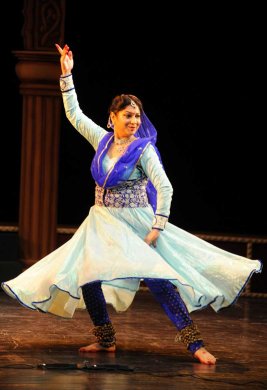 Anuradha Singh 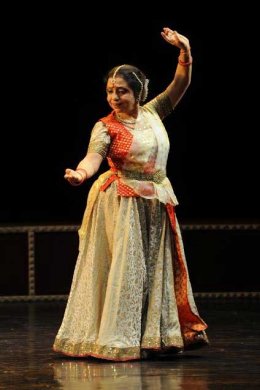 Kum Kum Dhar Kum Kum Dhar of Lucknow, a familiar face for Kathak lovers, and one of the most reputed of Guru Lachhu Maharaj's disciples, starting with Shiva Vandana in jhap tala, and the kavits like Ardhanareeswar, a nritta composition wherein the bol arrangements suggested Ched-Chad, and Durga paran, brought out her guru's penchant for seeing arrangements of bols in various intra forms as ideas and images expressed thorough abhinaya. The composition based on the 'Dhanur Bhang' episode in the Ramayan, aside from the theme's overuse by dancers of all disciplines, making it well nigh impossible for introducing original ideas, needed better musical accompaniment. Just the singing with Rajiv Shukla's tabla, despite time and age having sapped the voice of the singer (no mean artist with a history of much valuable work done for dancers), would have sufficed, without the sitar which was totally out of sur and pitched on a level at total variance with the rest of the music. Amongst the dancing pairs, forming the highlight of the festival, were the two disciples of Nad-Roop of Pune trained by Shama Bhate (herself the product of training under Rohini Bhate and Mohanrao Kalyanpurkar) - Avani Kiran Gadre and Ameera Pathankar. Not often that a dancer can boast of such vocal support as Vinay Ramadasan provided, with the masterful parhant of Shama Bhate. Starting with the mellifluous alap in Bhatiyar, Avani Kiran's abounding grace, portraying the softer qualities of the goddess in the Devi Vandana in Mangalacharan was offset by the sheer tandav power of the goddess as brought out in Ameera's flagrantly strong presentation. As for the teental intra-forms, the two dancers flowed in the 'ta thai tat' group of rhythmic flourishes, in the parmelu, Kavit composed by Rohini Bhate and in the Dha Tilang group where one composition was patterned to include the tisra, chatusra, khanda grouping of bols. Chaturang set to music in raag Desh, a composition of Mohanrao Kalyanpurkar was the finale - all rendered to the fine tabla accompaniment of Charudutt Phadke, (the decibel level so soothing with every mnemonic sound heard with musical clarity), Prasad Rohan on sitar and Chinmay Kokhtar on the harmonium. Very stylish and confident, each dancer had her own qualities and the performance evoked high applause with its artistic interaction -'Samvad' and all round presentational expertise. 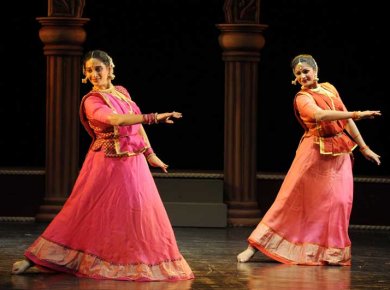 Avani Kiran Gadre & Ameera Pathankar ; Courtesy: Kathak Kendra 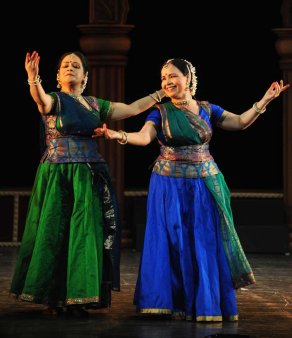 Malti Shyam & Shailaja Bisht Another very successful duet 'Dharohar' featured Malti Shyam and her present disciple Shailaja Bisht trained at Uttarakhand's Bhatkhande Sangeet Mahavidyalaya before coming under Guru Munna Shukla at the Kathak Kendra. Starting with every aspect of Krishna, so dear to devotees asking for a glimpse of the god who is the "rituvan naayak bahu sukha dayak" with mellow singer Santosh Kumar Sinha providing really tuneful music in Bhopali, accompanied by Aman Ali on tabla, Ghanashyam Sisodia on sarangi, Rohit Prasanna on flute and Yamika Mahesh providing parhant, the two dancers moved with excellent understanding in terms of how stage space was shared. Along with the impeccable ang, there is so much fluid grace in Malti's movements now. In the brief solo projection the tihais, and the springing cross-footed rhythmic arrangement were executed with silken ease. It is clear that Malti is now at the peak of her form. The nritta with parmelu, Ram Baan, and the movement of birds and nature in Spring "chanchala-chapala-chatura naara" given the fine music, was ruined by the tablist insisting on increasing the volume of his instrument to levels - making the rhythm sound like the bull in a china shop! The same sound system later worked so beautifully for the Pune musicians. Why this decibel level? Epitomizing tandav qualities and "dhamaka nritta" of the Benares tradition in every which way were the two male "priya bandhu" Ravi Shankar Misra and Mata Prasad Misra trained by Alakananda Devi, along with tabla playing expertise acquired under Panchu Maharaj. True to this gharana, the tabla percussion prelude by Preetam Kumar Misra was excellent. The "Nagendra haaraaya trilochanaaya" vandana having paid homage to the all powerful Shiva, the rain of rhythm began, the biting clarity of footwork at drut pace, of the two dancers (age making no difference to their dexterity) creating high level drama. A less strongly made performance surface could not have accommodated the sheer volume and vibrant masculine energy of the foot stomping rhythm - tossed off with nonchalance. Apart from Santosh Kumar Misra for the minimal vocal support, the all Misra entourage included Neerak Misra (sitar) and Preetam Kumar Misra for tabla. Among the group offers, Prerana Shrimali's creation 'Vivaksha' easily took the honours for a cerebral creation with fine ideas. Dwelling on the intrinsic nature of the parmelu, which incorporates within its entirety, all percussive and nature sounds, Prerana's work was inspired by a parmelu she learnt from Narayan Prasad. Starting with the pakhawaj mnemonics in vilambit laya, moving on to the faster gait of the tabla bols, the sounds and their arrangements seemed to elaborate and expand, seeking their own poetry of Kathak mnemonics - ultimately finishing at the starting point - the totality seeming to reflect a collage of abstract images representing akash, earth, air, waterfalls, nayak/nayika interactions and creatures of Nature. Keeping pace with the compositional creativity, the music devised imaginatively by Santosh Sinha, which began with the sonorous Dhrupad sounds, moved on to the Khyal and finally on to the thumri, other accompanying instruments joining in, keeping their individuality in mind. In this unique venture, one found all the Kathak ingredients finding a place. The choreography had unique geometrical formations - and what is more pleasing were the tasteful costumes and very finished nature of the young dancers - all students of Prerana. Apart from confidence, they had style in deportment, and stances with impeccable rhythm. Excellent work, though it started somewhat shakily with the otherwise good singer not able to hear the sounds and searching for the right microtone. But after half a minute, things settled down with everybody's comfort level up. Sheetal Ahmed (tabla), Nasir Khan (sarangi), Fateh Ali (sitar), Anurag (bansuri), Ashok Gangani (pakhawaj), with Prerana providing parhant comprised the full team. 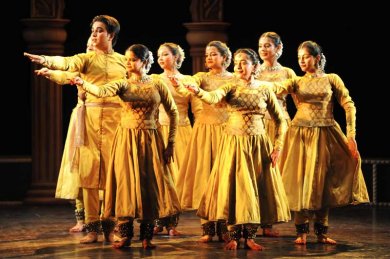 Prerana Shrimali's group ; Courtesy: Kathak Kendra 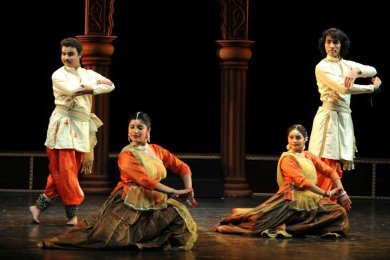 Rajendra Gangani's group 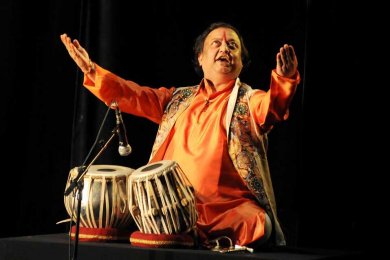 Jaikishan Maharaj 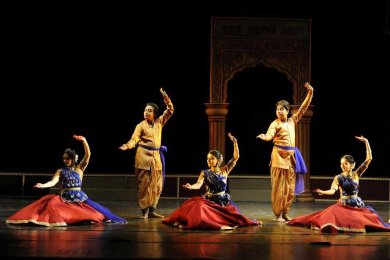 Jaikishan Maharaj's Kathak Kendra Repertory I found Rajendra Gangani's work slightly below par. It began with Guru Vandana which was the reason for the title 'Guru Bin Aisi Kaun Kare' and then went on to a classroom type of nritta with the boys and girls in rows performing. Yogesh (tabla), Samiullah Khan (singer), Mohammad Ayub Khan (sarangi), Akbar Hussein (sarod), Kiran Kumar (flute) made up the entire team of accompanists. Jaikishan Maharaj's students in parampara pravah had two girls and two boys, providing traditional glimpses of the tradition of his forefathers and father. The more high profile item was Swayambhu performed by the Repertory group, comprising some of the best students of the Kendra. The musical arrangement of the guru on one side (rest of the crew were on the opposite side) reciting bols and providing percussion interventions as conductor was dramatic. The work itself was based on the Hindu view of 'that which is self-born' and the reference to the 'kalash' or urn used in the rituals - regarded as representing the forces of the elements, and the residing Trimurti - Brahma at the root, Rudra in the vocal cords and neck and Vishnu on the top. While the dancing could not be faulted, one failed to find the connection with the philosophy. 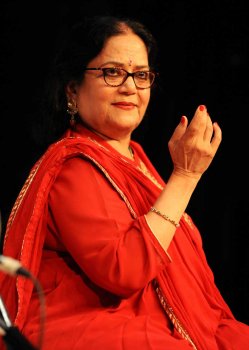 Sashi Shrinkhala 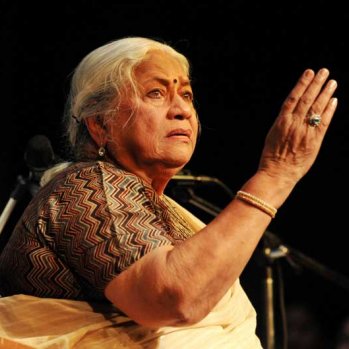 Kumudini Lakhia 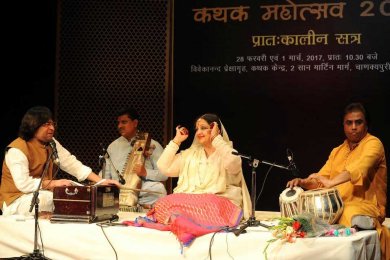 Nandini Singh 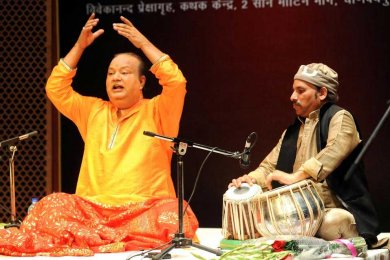 Ashok Maharaj  Writing on the dance scene for the last forty years, Leela Venkataraman's incisive comments on performances of all dance forms, participation in dance discussions both in India and abroad, and as a regular contributor to Hindu Friday Review, journals like Sruti and Nartanam, makes her voice respected for its balanced critiquing. She is the author of several books like Indian Classical dance: Tradition in Transition, Classical Dance in India and Indian Classical dance: The Renaissance and Beyond. Post your comments Please provide your name and email id when you use the Anonymous profile in the blog to post a comment. All appropriate comments posted with name & email id in the blog will also be featured in the site. |